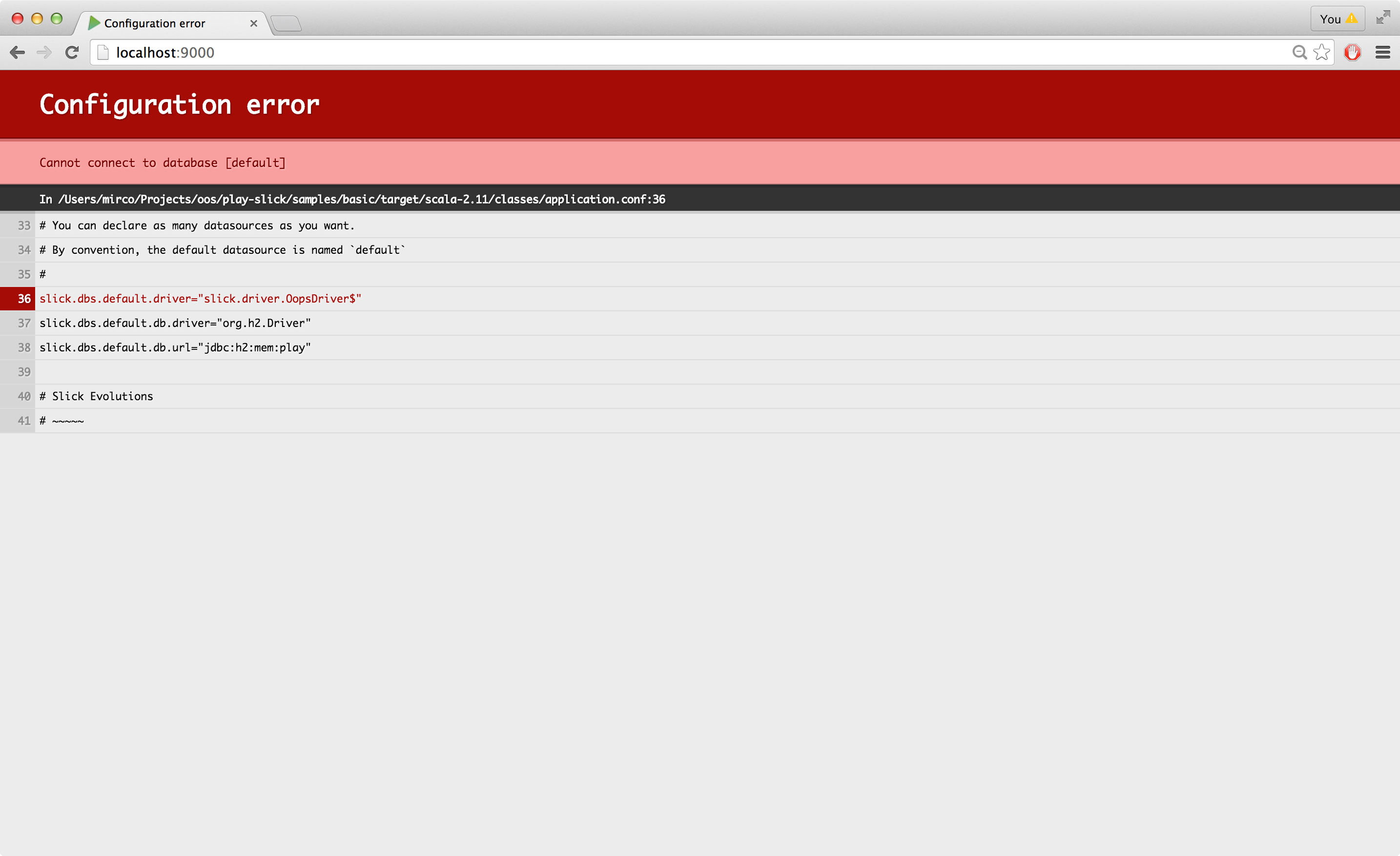§Using Play Slick
The Play Slick module makes Slick a first-class citizen of Play.
The Play Slick module consists of two features:
- Integration of Slick into Play’s application lifecycle.
- Support for Play database evolutions.
Play Slick currently supports Slick 3.0 with Play 2.4, for both Scala 2.10 and 2.11. If you need to use an older version of Play or Slick, have a look at the compatibility matrix in the play-slick README to know what version you should be using. Mind that the remainder of this guide explains how to use the latest release of Play Slick, and will not be appropriate if you are using version 0.8 or lower.
Note: This guide assumes you already know both Play 2.4 and Slick 3.0. Also, it assumes you will be using the new Slick Database I/O Actions API. In fact, using the deprecated Invoker/Execution API of Slick should be possible, but it might not be as convenient. Also, be aware that the Invoker/Execution API is planned to be removed in the next major release of Slick.
§Getting Help
If you are having trouble using Play Slick, check if the FAQ contains the answer. Otherwise, feel free to reach out to play-framework user group for any question.
Also, note that if you are seeking help on Slick, the slick user group may be a better place to get support.
§About this release
If you have been using a previous version of Play Slick, you will immediately notice that there have been quite a few major changes. It’s recommended to read the migration guide for a smooth upgrade.
While, if this is the first time you are using Play Slick, you will appreciate that the integration of Slick in Play is quite austere. Meaning that if you know both Play and Slick, using Play Slick in your project should be straightforward.
§Setup
Add a library dependency on play-slick:
"com.typesafe.play" %% "play-slick" % "1.0.0-RC1"
The above dependency will also bring along the Slick library as a transitive dependency. This implies you don’t need to add an explicit dependency on Slick.
Please, double-check in the play-slick README that the Play Slick version used here is indeed the latest release of Play Slick (you know it all too well, duplicated information has a tendency to become obsolete).
§Database Configuration
To have Play Slick module handling the lifecycle of Slick databases, it is important that you never create database’s instances explicitly in your code. Rather, you should provide a valid Slick driver and database configuration in your application.conf (by convention the default Slick database must be called default):
# Default database configuration
slick.dbs.default.driver="slick.driver.H2Driver$"
slick.dbs.default.db.driver="org.h2.Driver"
slick.dbs.default.db.url="jdbc:h2:mem:play"
To configure several databases:
# Orders database
slick.dbs.orders.driver="slick.driver.H2Driver$"
slick.dbs.orders.db.driver="org.h2.Driver"
slick.dbs.orders.db.url="jdbc:h2:mem:play"
# Customers database
slick.dbs.customers.driver="slick.driver.H2Driver$"
slick.dbs.customers.db.driver="org.h2.Driver"
slick.dbs.customers.db.url="jdbc:h2:mem:play"
If something isn’t properly configured, you will be notified in your browser:
Note: Play Slick module will only work if you provide a valid Slick configuration.
The examples above are all using H2, but Slick supports several other databases. Have a look at the Slick documentation for a complete list of supported databases (and to find the matching Slick driver to use).
Also, for the complete list of configuration parameters that you can use in your project’s application.conf, see the Slick ScalaDoc for Database.forConfig.
§Usage
After having properly configured a Slick database, you can obtain a DatabaseConfig (which is a Slick type bundling a database and driver) in two different ways. Either by using dependency injection, or through a global lookup via the DatabaseConfigProvider singleton.
Note: A Slick database instance manages a thread pool and a connection pool. In general, you should not need to shut down a database explicitly in your code (by calling its
closemethod), as the Play Slick module takes care of this already.
§DatabaseConfig via Dependency Injection
Here is an example of how to inject a DatabaseConfig instance for the default database (i.e., the database named default in your configuration):
class Application @Inject()(dbConfigProvider: DatabaseConfigProvider) extends Controller {
val dbConfig = dbConfigProvider.get[RelationalProfile]Injecting a DatabaseConfig instance for a different database is also easy. Simply prepend the annotation @NamedDatabase("<db-name>") to the dbConfigProvider constructor parameter:
class Application2 @Inject()(@NamedDatabase("<db-name>") dbConfigProvider: DatabaseConfigProvider) extends Controller {Of course, you should replace the string "<db-name>" with the name of the database’s configuration you want to use.
For a full example, have a look at this sample projet.
§DatabaseConfig via Global Lookup
Here is an example of how to lookup a DatabaseConfig instance for the default database (i.e., the database named default in your configuration):
val dbConfig = DatabaseConfigProvider.get[RelationalProfile](Play.current)Looking up a DatabaseConfig instance for a different database is also easy. Simply pass the database name:
val dbConfig = DatabaseConfigProvider.get[RelationalProfile]("<db-name>")(Play.current)Of course, you should replace the string "<db-name>" with the name of the database’s configuration you want to use.
For a full example, have a look at this sample projet.
§Running a database query in a Controller
To run a database query in your controller, you will need both a Slick database and driver. Fortunately, from the above we now know how to obtain a Slick DatabaseConfig, hence we have what we need to run a database query.
You will need to import some types and implicits from the driver:
import dbConfig.driver.api._And then you can define a controller’s method that will run a database query:
def index(name: String) = Action.async { implicit request =>
val resultingUsers: Future[Seq[User]] = dbConfig.db.run(Users.filter(_.name === name).result)
resultingUsers.map(users => Ok(views.html.index(users)))
}That’s just like using stock Play and Slick!
§Support for Play database evolutions
Play Slick supports Play database evolutions.
To enable evolutions, add the following dependency to your project’s build:
libraryDependencies += "com.typesafe.play" %% "play-slick-evolutions" % "1.0.0-RC1"




